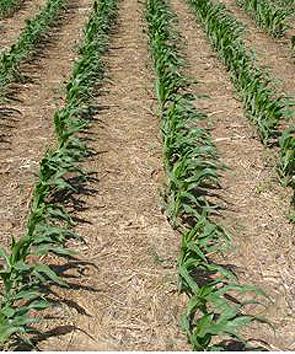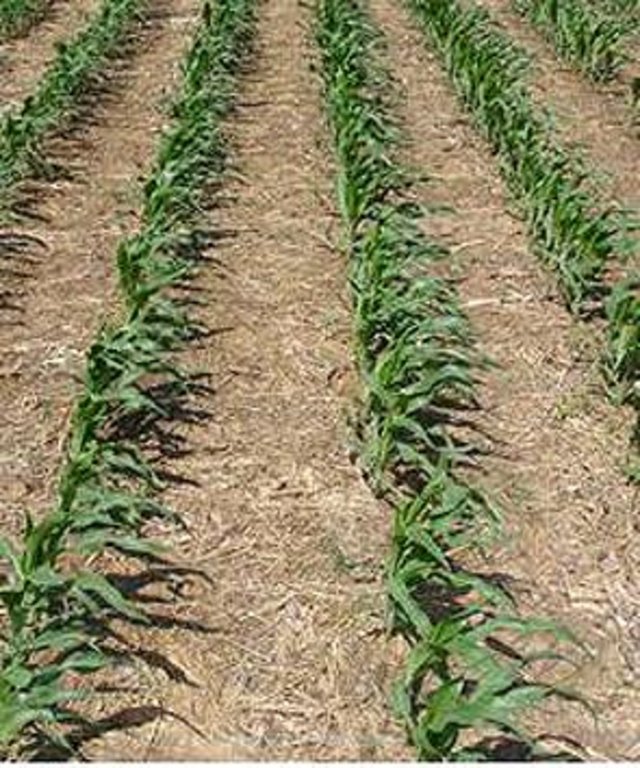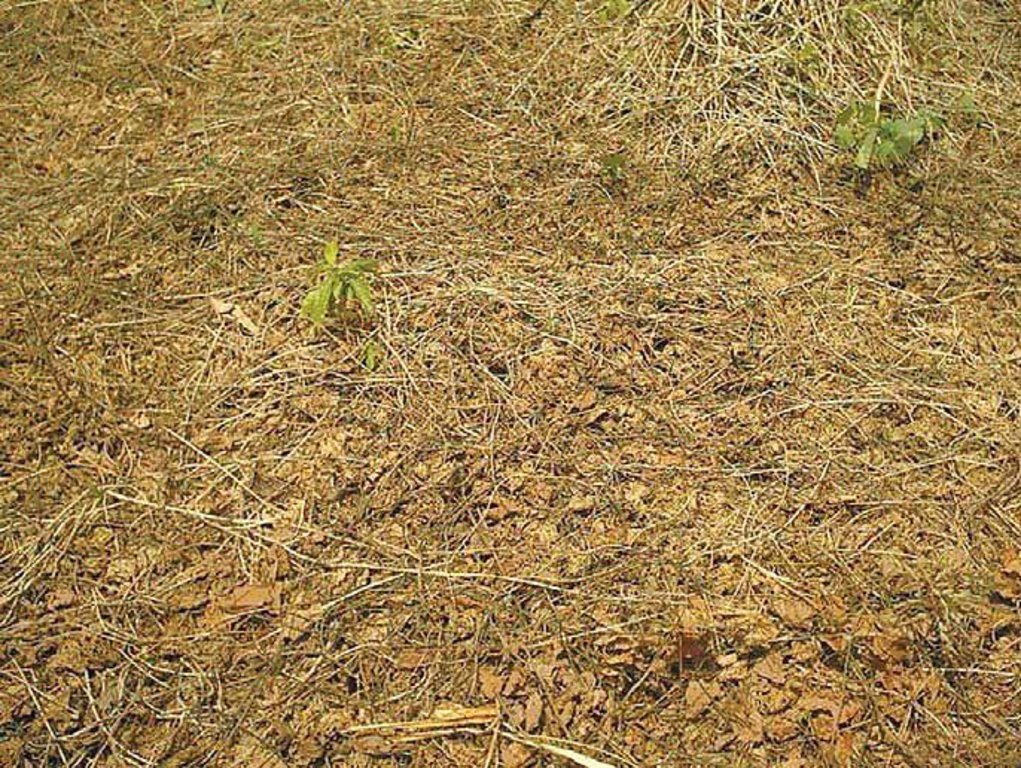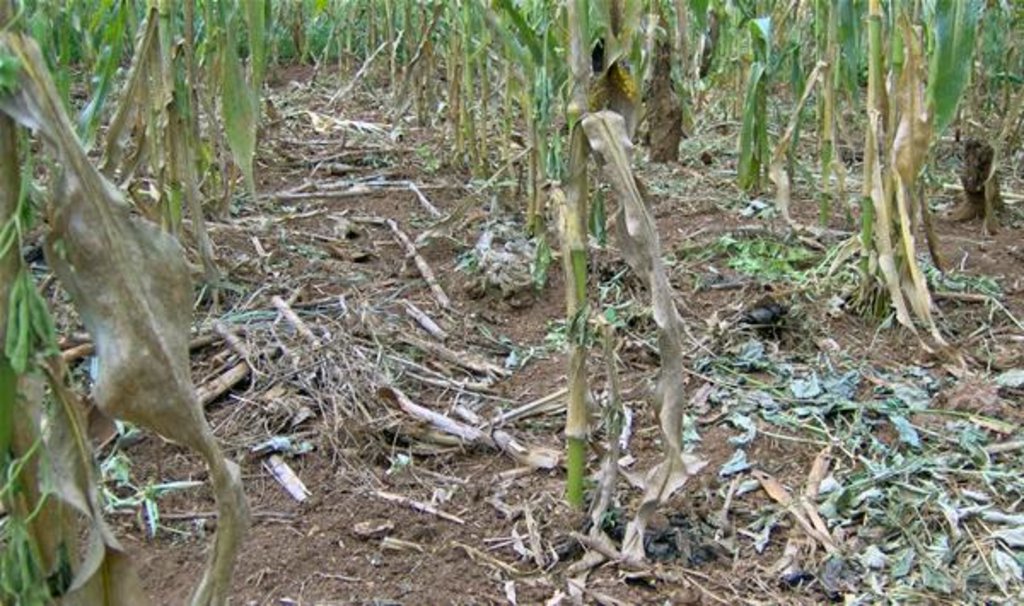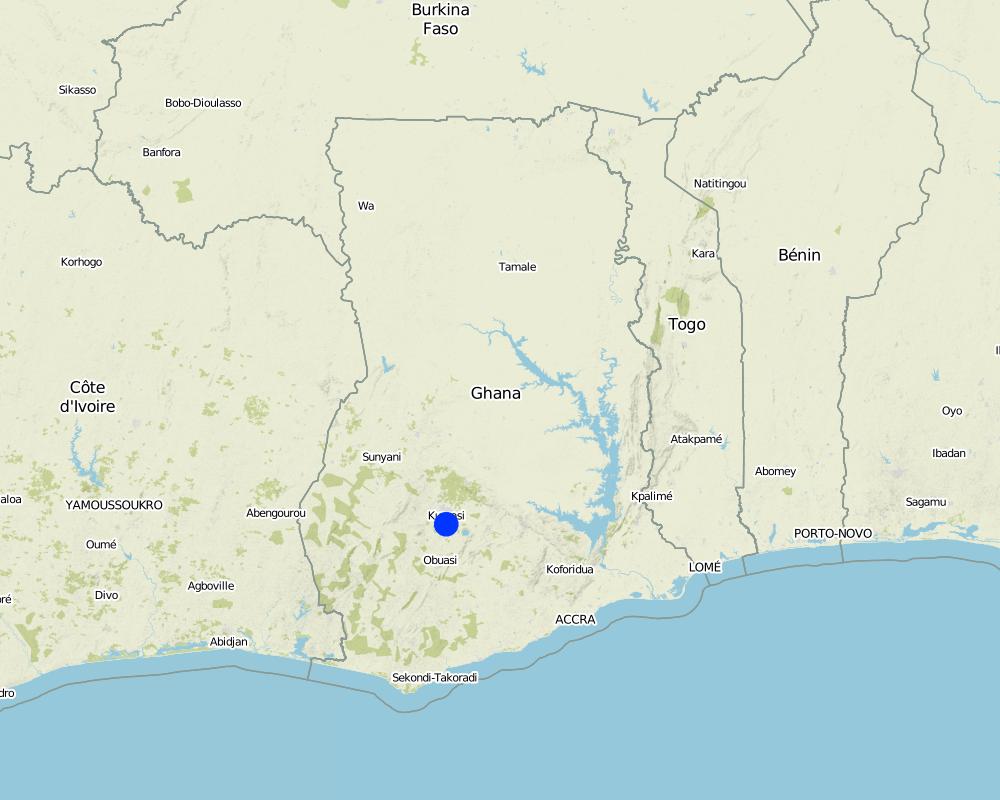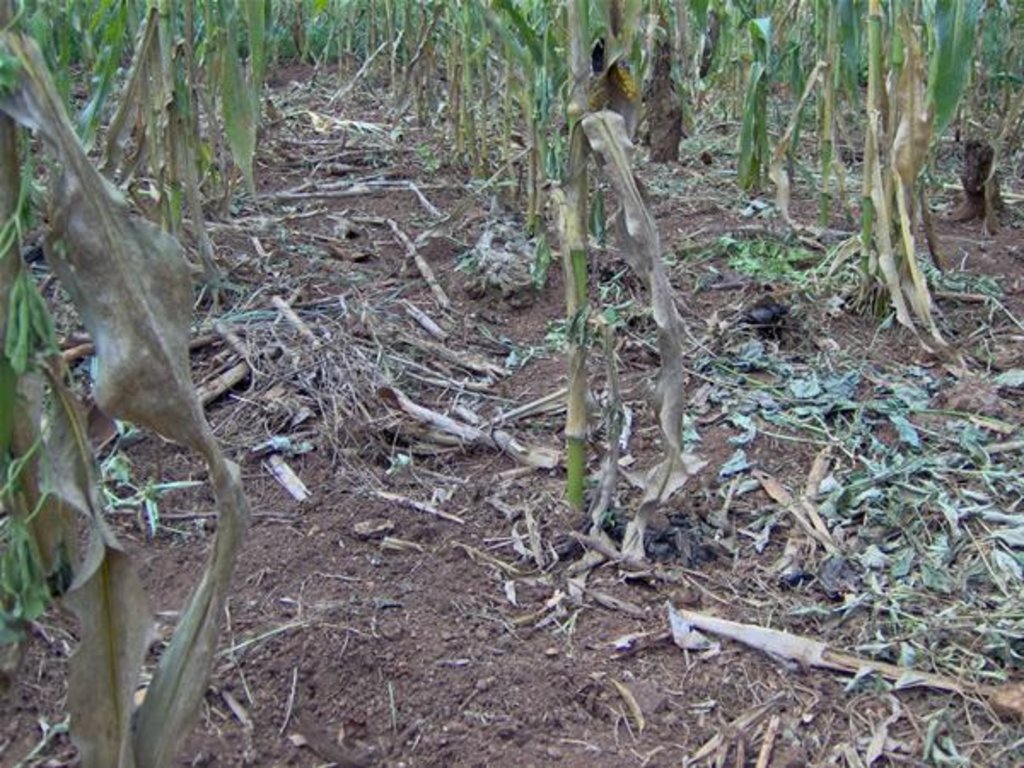Minimum Tillage and Direct Planting [กานา]
- ผู้สร้างสรรค์:
- การอัพเดท:
- ผู้รวบรวม: Unknown User
- ผู้เรียบเรียง: –
- ผู้ตรวจสอบ: Fabian Ottiger
technologies_1329 - กานา
ดูส่วนย่อย
ขยายทั้งหมด ย่อทั้งหมด1. ข้อมูลทั่วไป
1.2 รายละเอียดที่ติดต่อได้ของผู้รวบรวมและองค์กรที่เกี่ยวข้องในการประเมินและการจัดเตรียมทำเอกสารของเทคโนโลยี
วิทยากรหลัก
ผู้เชี่ยวชาญ SLM:
Adjimon Souroudjaye
volenvicon@gmail.com
Volta Environmental Conservation Organization
กานา
ชื่อของโครงการซึ่งอำนวยความสะดวกในการทำเอกสารหรือการประเมินเทคโนโลยี (ถ้าเกี่ยวข้อง)
Book project: SLM in Practice - Guidelines and Best Practices for Sub-Saharan Africa (SLM in Practice)1.3 เงื่อนไขการใช้ข้อมูลที่ได้บันทึกผ่านทาง WOCAT
ผู้รวบรวมและวิทยากรหลักยอมรับเงื่อนไขเกี่ยวกับการใช้ข้อมูลที่ถูกบันทึกผ่านทาง WOCAT:
ใช่
2. การอธิบายลักษณะของเทคโนโลยี SLM
2.1 การอธิบายแบบสั้น ๆ ของเทคโนโลยี
คำจำกัดความของเทคโนโลยี:
Minimum tillage and direct planting are two conservation agriculture practices which basically consist of leaving crop residues on the soil surface without burning and subsequent planting through the mulch.
2.2 การอธิบายแบบละเอียดของเทคโนโลยี
คำอธิบาย:
The traditional slash-and-burn land use system in the case study area – involving clearing natural vegetation followed by 2-5 years of cropping – has become unsustainable as land pressure has greatly increased, shortening fallow periods. Under the SLM practice of ‘minimum tillage and direct planting’, land is prepared by slashing the existing vegetation and allowing regrowth up to 30 cm height. A glyphosate-based round-up herbicide (Round-up, Chemosate or Helosate) is sprayed with a knapsack fitted with a low-volume nozzle. The residue is left on the soil surface without burning. After 7–10 days, direct planting is carried out in rows through the mulch. Maize is the main crop planted under this system. Planting is practiced manually using a planting stick.
Purpose of the Technology: The mulch layer has several important functions: it helps to increase and maintain water stored in the soil, reduces soil erosion, contributes to improve soil fertility (after crop residues have decomposed in subsequent seasons) and it efficiently controls weeds by hindering their growth and preventing weeds from producing seeds. The use of herbicides requires adequate knowledge. An even better option is to introduce multipurpose cover crops to control weed populations, improve soil fertility, and enhance yields while diversifying crop production and thus reducing dependence on the use of herbicides. Labour inputs for land preparation and weeding is considerably decreased under conservation agriculture. Women benefit most from the workload reduction since these time-consuming activities are their task. For men, the new technology usually means heavier work, especially during the 1st year, since they have to plant through the mulch. Using a jab planter makes the work easier
Establishment / maintenance activities and inputs: Minimum tillage and direct planting includes the following recurrent activities: 1. Initial land clearing: slash existing vegetation and allow regrowth (up to 30 cm); before onset of rains season.
2. Spraying of pre-emergence herbicide; 300 ml (2 sachets) for every 15 litres water for annual weeds; 450 ml (3 sachets) for every 15 litres water for perennial weeds.
3. Leave residues on the soil surface without burning.
4. Planting through the mulch.
5. Spraying post-emergence herbicide; after regrowth of weeds (7-10 days after planting).
6. Harvesting.
All activities are carried out manually (each cropping season) using jap planter (or a planting stick) and knapsack sprayers.
Natural / human environment: Both case study areas fall within the wet semi-equatorial zone of Ghana with a mean monthly temperature of between 23 °C and 33 °C (SDA 1995). Rainfall is bimodal in both districts with a peak rainy season from the end of March to July and again from September to November, after a short dry spell in August. In general soil characteristics in the study areas vary from well drained with high organic matter content in the forest area, to poorly drained with low organic matter content in the savannah belt.
2.3 รูปภาพของเทคโนโลยี
2.5 ประเทศภูมิภาค หรือสถานที่ตั้งที่เทคโนโลยีได้นำไปใช้และได้รับการครอบคลุมโดยการประเมินนี้
ประเทศ:
กานา
ภูมิภาค/รัฐ/จังหวัด:
Brong Ahafo Region
ข้อมูลจำเพาะเพิ่มเติมของสถานที่ตั้ง :
Sunyani and Atwima district
Map
×2.6 วันที่การดำเนินการ
ถ้าไม่รู้ปีที่แน่นอน ให้ระบุวันที่โดยประมาณ:
- 10-50 ปี
2.7 คำแนะนำของเทคโนโลยี
ให้ระบุว่าเทคโนโลยีถูกแนะนำเข้ามาอย่างไร:
- ในช่วงการทดลองหรือการทำวิจัย
ความคิดเห็น (ประเภทของโครงการ เป็นต้น) :
early 1990s
3. การจัดประเภทของเทคโนโลยี SLM
3.1 วัตถุประสงค์หลักของเทคโนโลยี
- ปรับปรุงการผลิตให้ดีขึ้น
- ลด ป้องกัน ฟื้นฟู การเสื่อมโทรมของที่ดิน
- ปรับตัวเข้ากับการเปลี่ยนแปลงภูมิอากาศของโลก สภาพภูมิอากาศที่รุนแรงและผลกระทบ
- สร้างผลกระทบทางด้านเศรษฐกิจที่เป็นประโยชน์
3.2 ประเภทของการใช้ที่ดินในปัจจุบันที่ได้นำเทคโนโลยีไปใช้

พื้นที่ปลูกพืช
- การปลูกพืชล้มลุกอายุปีเดียว
แสดงความคิดเห็น:
Major land use problems (land users’ perception): Fertility decline and reduced organic matter, water erosion, destruction of vegetation trough fires
3.4 กลุ่ม SLM ที่ตรงกับเทคโนโลยีนี้
- การปรับปรุงดิน / พืชคลุมดิน
- การรบกวนดินให้น้อยที่สุด
3.6 มาตรการ SLM ที่ประกอบกันเป็นเทคโนโลยี

มาตรการจัดการพืช
- A1: พืช/สิ่งปกคลุมดิน

มาตรการอนุรักษ์ด้วยการจัดการ
- M2: การเปลี่ยนแปลงของการจัดการหรือระดับความเข้มข้น
แสดงความคิดเห็น:
Main measures: agronomic measures
Secondary measures: management measures
3.7 รูปแบบหลักของการเสื่อมโทรมของที่ดินที่ได้รับการแก้ไขโดยเทคโนโลยี

การกัดกร่อนของดินโดยน้ำ
- Wt (Loss of topsoil): การสูญเสียดินชั้นบนหรือการกัดกร่อนที่ผิวดิน

การเสื่อมโทรมของดินทางด้านเคมี
- Cn (Fertility decline): ความอุดมสมบูรณ์และปริมาณอินทรียวัตถุในดินถูกทำให้ลดลงไป (ไม่ได้เกิดจากสาเหตุการกัดกร่อน)

การเสื่อมโทรมของดินทางด้านชีวภาพ
- Bq (Quantity/biomass decline): การลดลงของปริมาณหรือมวลชีวภาพ
- Bf (Detrimenta leffects of fires): ผลเสียหายจากไฟ
แสดงความคิดเห็น:
Main type of degradation addressed: Wt: loss of topsoil / surface erosion, Cn: fertility decline and reduced organic matter content
Secondary types of degradation addressed: Bq: quantity / biomass decline, Bf: detrimental effects of fires
Main causes of degradation: soil management, population pressure, land tenure
3.8 การป้องกัน การลดลง หรือการฟื้นฟูความเสื่อมโทรมของที่ดิน
ระบุเป้าหมายของเทคโนโลยีกับความเสื่อมโทรมของที่ดิน:
- ป้องกันความเสื่อมโทรมของที่ดิน
- ลดความเสื่อมโทรมของดิน
4. ข้อมูลจำเพาะด้านเทคนิค กิจกรรมการนำไปปฏิบัติใช้ ปัจจัยนำเข้า และค่าใช้จ่าย
4.1 แบบแปลนทางเทคนิคของเทคโนโลยี
4.2 ข้อมูลจำเพาะด้านเทคนิคและการอธิบายแบบแปลนทางเทคนิค
Residue management on a field with mature maize plants
Technical knowledge required for field staff / advisors: moderate
Technical knowledge required for land users: moderate
Main technical functions: control of raindrop splash, improvement of ground cover, increase in organic matter, increase in nutrient availability (supply, recycling,…), increase / maintain water stored in soil
4.4 กิจกรรมเพื่อการจัดตั้ง
| กิจกรรม | ประเภทของมาตรการ | ช่วงเวลาดำเนินการ | |
|---|---|---|---|
| 1. | Purchase jab planter | จัดการพืช | |
| 2. | Purchase herbicides | จัดการพืช | |
| 3. | Purchase knapsack | จัดการพืช |
4.5 ค่าใช้จ่ายของปัจจัยนำเข้าที่จำเป็นสำหรับการจัดตั้ง
| ปัจจัยนำเข้า | หน่วย | ปริมาณ | ค่าใช้จ่ายต่อหน่วย | ค่าใช้จ่ายทั้งหมดต่อปัจจัยนำเข้า | %ของค่าใช้จ่ายที่ก่อให้เกิดขึ้นโดยผู้ใช้ที่ดิน | |
|---|---|---|---|---|---|---|
| อุปกรณ์ | Tools | ha | 1.0 | 70.0 | 70.0 | 100.0 |
| ค่าใช้จ่ายทั้งหมดของการจัดตั้งเทคโนโลยี | 70.0 | |||||
แสดงความคิดเห็น:
Remarks: Input costs include Jab planter US$ 20; herbicides US$ 5-6/liter. A knapsack costs US$ 50, which not affordable for small-scale farmers (they have to get organised in groups, or hire spraying gangs). Comparing to the traditional slash-and-burn system, Minimum tillage and direct planting has increased inputs costs but reduced labour costs and higher yields, which makes the conversion profitable!
4.6 การบำรุงรักษาสภาพหรือกิจกรรมที่เกิดขึ้นเป็นประจำ
| กิจกรรม | ประเภทของมาตรการ | ช่วงระยะเวลา/ความถี่ | |
|---|---|---|---|
| 1. | Initial land clearing: slash existing vegetation and allow regrowth (up to 30 cm) | จัดการพืช | before onset of rainy season |
| 2. | Spraying of pre-emergence herbicide; 300 ml (2 sachets) for every 15 litres water for annual weeds; 450 ml (3 sachets) for every 15 litres water for perennial weeds | จัดการพืช | |
| 3. | Leave residues on the soil surface without burning | จัดการพืช | |
| 4. | Planting through the mulch | จัดการพืช | |
| 5. | Spraying post-emergence herbicide; after regrowth of weeds | จัดการพืช | 7-10 days after planting |
4.7 ค่าใช้จ่ายของปัจจัยนำเข้าและกิจกรรมที่เกิดขึ้นเป็นประจำที่ต้องการการบำรุงรักษา (ต่อปี)
| ปัจจัยนำเข้า | หน่วย | ปริมาณ | ค่าใช้จ่ายต่อหน่วย | ค่าใช้จ่ายทั้งหมดต่อปัจจัยนำเข้า | %ของค่าใช้จ่ายที่ก่อให้เกิดขึ้นโดยผู้ใช้ที่ดิน | |
|---|---|---|---|---|---|---|
| แรงงาน | Labour | ha | 1.0 | 83.0 | 83.0 | 100.0 |
| อุปกรณ์ | Tools | ha | 1.0 | 18.0 | 18.0 | |
| ปุ๋ยและสารฆ่า/ยับยั้งการเจริญเติบโตของสิ่งมีชีวิต (ไบโอไซด์) | Herbicides | ha | 1.0 | 110.0 | 110.0 | |
| ค่าใช้จ่ายทั้งหมดของการบำรุงรักษาสภาพเทคโนโลยี | 211.0 | |||||
แสดงความคิดเห็น:
Machinery/ tools: jap planter, knapsack sprayer
4.8 ปัจจัยสำคัญที่สุดที่มีผลกระทบต่อค่าใช้จ่าย
ปัจจัยสำคัญที่สุดที่มีผลกระทบต่อค่าใช้จ่ายต่างๆ:
Costs for herbicides and spraying equipment are the most determinant factor affecting the costs. Comparing to the traditional slash-and-burn system, Minimum tillage and direct planting has increased inputs costs but reduced labour costs and higher yields, which makes the conversion profitable!
5. สิ่งแวดล้อมทางธรรมชาติและของมนุษย์
5.1 ภูมิอากาศ
ฝนประจำปี
- < 250 ม.ม.
- 251-500 ม.ม.
- 501-750 ม.ม.
- 751-1,000 ม.ม.
- 1,001-1,500 ม.ม.
- 1,501-2,000 ม.ม.
- 2,001-3,000 ม.ม.
- 3,001-4,000 ม.ม.
- > 4,000 ม.ม.
ข้อมูลจำเพาะ/ความคิดเห็นเรื่องปริมาณน้ำฝน:
1400-1850 mm, bimodal
เขตภูมิอากาศเกษตร
- กึ่งชุ่มชื้น
Thermal climate class: tropics
5.2 สภาพภูมิประเทศ
ค่าเฉลี่ยความลาดชัน:
- ราบเรียบ (0-2%)
- ลาดที่ไม่ชัน (3-5%)
- ปานกลาง (6-10%)
- เป็นลูกคลื่น (11-15%)
- เป็นเนิน (16-30%)
- ชัน (31-60%)
- ชันมาก (>60%)
ธรณีสัณฐาน:
- ที่ราบสูง/ที่ราบ
- สันเขา
- ไหล่เขา
- ไหล่เนินเขา
- ตีนเนิน
- หุบเขา
ระดับความสูง:
- 0-100 เมตร
- 101-500 เมตร
- 501-1,000 เมตร
- 1,001-1,500 เมตร
- 1,501-2,000 เมตร
- 2,001-2,500 เมตร
- 2,501-3,000 เมตร
- 3,001-4,000 เมตร
- > 4,000 เมตร
ความคิดเห็นและข้อมูลจำเพาะเพิ่มเติมเรื่องสภาพภูมิประเทศ:
Altitudinal zone: 101-500 m a.s.l. (220-380 m a.s.l.)
5.3 ดิน
ค่าเฉลี่ยความลึกของดิน:
- ตื้นมาก (0-20 ซ.ม.)
- ตื้น (21-50 ซ.ม.)
- ลึกปานกลาง (51-80 ซ.ม.)
- ลึก (81-120 ซ.ม.)
- ลึกมาก (>120 ซ.ม.)
อินทรียวัตถุในดิน:
- สูง (>3%)
- ต่ำ (<1%)
(ถ้ามี) ให้แนบคำอธิบายเรื่องดินแบบเต็มหรือระบุข้อมูลที่มีอยู่ เช่น ชนิดของดิน ค่า pH ของดินหรือความเป็นกรดของดิน ความสามารถในการแลกเปลี่ยนประจุบวก ไนโตรเจน ความเค็ม เป็นต้น:
Topsoil organic matter: High (forest area) and low (savannah area)
Soil drainage/infiltration: High (forest area) and low (savannah area)
5.5 ความหลากหลายทางชีวภาพ
ความหลากหลายทางชนิดพันธุ์:
- สูง
5.6 ลักษณะของผู้ใช้ที่ดินที่นำเทคโนโลยีไปปฏิบัติใช้
แนวทางการตลาดของระบบการผลิต:
- เพื่อการยังชีพ (หาเลี้ยงตนเอง)
- ผสม (การเลี้ยงชีพ/ทำการค้า)
ระดับของความมั่งคั่งโดยเปรียบเทียบ:
- จน
เป็นรายบุคคล/ครัวเรือน:
- เป็นรายบุคคล/ครัวเรือน
ระดับของการใช้เครื่องจักรกล:
- งานที่ใช้แรงกาย
เพศ:
- หญิง
- ชาย
ระบุลักษณะอื่นๆที่เกี่ยวข้องของผู้ใช้ที่ดิน:
Population density: 100-200 persons/km2
100% of the land users are poor.
5.7 พื้นที่เฉลี่ยของที่ดินที่เป็นเจ้าของหรือเช่าโดยผู้ใช้ที่ดินที่นำเทคโนโลยีไปปฏิบัติใช้
- < 0.5 เฮกตาร์
- 0.5-1 เฮกตาร์
- 1-2 เฮกตาร์
- 2-5 เฮกตาร์
- 5-15 เฮกตาร์
- 15-50 เฮกตาร์
- 50-100 เฮกตาร์
- 100-500 เฮกตาร์
- 500-1,000 เฮกตาร์
- 1,000-10,000 เฮกตาร์
- >10,000 เฮกตาร์
พิจารณาว่าเป็นขนาดเล็ก กลาง หรือขนาดใหญ่ (ซึ่งอ้างอิงถึงบริบทระดับท้องถิ่น):
- ขนาดเล็ก
5.8 กรรมสิทธิ์ในที่ดิน สิทธิในการใช้ที่ดินและสิทธิในการใช้น้ำ
กรรมสิทธิ์ในที่ดิน:
- เป็นแบบชุมชนหรือหมู่บ้าน
- รายบุคคล ได้รับสิทธิครอบครอง
สิทธิในการใช้ที่ดิน:
- เช่า
- รายบุคคล
6. ผลกระทบและสรุปคำบอกกล่าว
6.1 ผลกระทบในพื้นที่ดำเนินการ (On-site) จากการใช้เทคโนโลยี
ผลกระทบทางด้านเศรษฐกิจและสังคม
การผลิต
การผลิตพืชผล
จำนวนก่อน SLM:
0.75-1 t
หลังจาก SLM:
3t / ha
รายได้และค่าใช้จ่าย
ค่าใช่จ่ายของปัจจัยการผลิตทางการเกษตร
แสดงความคิดเห็น/ระบุ:
Only input costs are higher than for slash and burn, but labour costs are reduced
รายได้จากฟาร์ม
จำนวนก่อน SLM:
50 US
หลังจาก SLM:
123 US
ภาระงาน
จำนวนก่อน SLM:
83
หลังจาก SLM:
48
แสดงความคิดเห็น/ระบุ:
Critical labour shortage at weeding time is avoided, increased labour constraints only in the first year
ผลกระทบทางด้านเศรษฐกิจและสังคมอื่น ๆ
Possibility of early planting
แสดงความคิดเห็น/ระบุ:
Benefit from early rains, due to minimal land prep.
ผลกระทบด้านสังคมวัฒนธรรมอื่น ๆ
สถานการณ์ด้านสุขภาพ
แสดงความคิดเห็น/ระบุ:
Might occur if no proper handling of herbicides is ensured
สถานการณ์ของกลุ่มด้อยโอกาส ทางด้านสังคมและเศรษฐกิจ
แสดงความคิดเห็น/ระบุ:
Women / children benefit most from workload reduction
ผลกระทบด้านนิเวศวิทยา
วัฐจักรน้ำหรือน้ำบ่า
การเก็บเกี่ยวหรือการกักเก็บน้ำ
ดิน
ความชื้นในดิน
สิ่งปกคลุมดิน
การสูญเสียดิน
6.3 การเผชิญและความตอบสนองของเทคโนโลยีต่อการเปลี่ยนแปลงสภาพภูมิอากาศที่ค่อยเป็นค่อยไป และสภาพรุนแรงของภูมิอากาศ / ภัยพิบัติ (ที่รับรู้ได้โดยผู้ใช้ที่ดิน)
การเปลี่ยนแปลงสภาพภูมิอากาศที่ค่อยเป็นค่อยไป
การเปลี่ยนแปลงสภาพภูมิอากาศที่ค่อยเป็นค่อยไป
| ฤดู | ประเภทของการเปลี่ยนแปลงสภาพภูมิอากาศที่ค่อยเป็นค่อยไป และสภาพรุนแรงของภูมิอากาศ | เทคโนโลยีมีวิธีการรับมืออย่างไร | |
|---|---|---|---|
| อุณหภูมิประจำปี | เพิ่มขึ้น | ดี |
สภาพรุนแรงของภูมิอากาศ (ภัยพิบัติ)
ภัยพิบัติทางอุตุนิยมวิทยา
| เทคโนโลยีมีวิธีการรับมืออย่างไร | |
|---|---|
| พายุฝนประจำท้องถิ่น | ดี |
| พายุลมประจำท้องถิ่น | ไม่ทราบ |
ภัยพิบัติจากสภาพภูมิอากาศ
| เทคโนโลยีมีวิธีการรับมืออย่างไร | |
|---|---|
| ภัยจากฝนแล้ง | ดี |
ภัยพิบัติจากน้ำ
| เทคโนโลยีมีวิธีการรับมืออย่างไร | |
|---|---|
| น้ำท่วมตามปกติ (แม่น้ำ) | ไม่ทราบ |
ผลลัพธ์ตามมาที่เกี่ยวข้องกับภูมิอากาศอื่น ๆ
ผลลัพธ์ตามมาที่เกี่ยวข้องกับภูมิอากาศอื่น ๆ
| เทคโนโลยีมีวิธีการรับมืออย่างไร | |
|---|---|
| ช่วงการปลูกพืชที่ลดลงมา | ดี |
แสดงความคิดเห็น:
The technology is tolerant to climatic extremes, contrary to the traditional slash-and-burn practice
6.4 การวิเคราะห์ค่าใช้จ่ายและผลประโยชน์ที่ได้รับ
ผลประโยชน์ที่ได้รับเปรียบเทียบกับค่าใช้จ่ายในการบำรุงรักษาหรือต้นทุนที่เกิดขึ้นซ้ำอีก เป็นอย่างไร (จากมุมมองของผู้ใช้ที่ดิน)
ผลตอบแทนระยะสั้น:
เป็นกลางหรือสมดุล
ผลตอบแทนระยะยาว:
ด้านบวก
6.5 การปรับตัวของเทคโนโลยี
ถ้ามีข้อมูลให้บอกปริมาณด้วย (จำนวนของครัวเรือนหรือครอบคลุมพื้นที่):
193 households and 100% of the area covered
จากทั้งหมดที่ได้รับเทคโนโลยีเข้ามามีจำนวนเท่าใดที่ทำแบบทันที โดยไม่ได้รับการจูงใจด้านวัสดุหรือการเงินใด ๆ:
- 10-50%
แสดงความคิดเห็น:
88% of land user families have adopted the Technology with external material support
170 land user families have adopted the Technology with external material support
12% of land user families have adopted the Technology without any external material support
23 land user families have adopted the Technology without any external material support
There is no trend towards spontaneous adoption of the Technology
Comments on adoption trend: 30% of farmers ceased conservation farming practices after termination of projects input. 21 communities with 193 farmers (125 male, 68 female) apply the technology in the case study area (totally 2845 km2). Around 88% accepted the technology receiving incentives. There is little trend towards spontaneous adoption (through cross farmer visits); 30% of farmers ceased conservation farming practices after termination of projects input
6.7 จุดแข็ง / ข้อได้เปรียบ / โอกาสของเทคโนโลยี
| จุดแข็ง / ข้อได้เปรียบ / โอกาสในทัศนคติของผู้รวบรวมหรือวิทยากรหลัก |
|---|
| Increased crop yield |
| Increased farm income |
6.8 จุดอ่อน / ข้อเสียเปรียบ / ความเสี่ยงของเทคโนโลยีและวิธีการแก้ไข
| จุดอ่อน / ข้อเสียเปรียบ / ความเสี่ยงในทัศนคติของผู้ใช้ที่ดิน | มีวิธีการแก้ไขได้อย่างไร |
|---|---|
| High amounts of soil cover impeded germination of the main crop, thereby affecting productivity | partial burning appeared necessary in such cases to reduce the quantity of mulch on the field |
| Fields that had been ploughed for years recorded slightly lower yield with minimal tillage and herbicide application, probably due to ploughing pan formation (hindering root penetration) | ripping |
| จุดอ่อน / ข้อเสียเปรียบ / ความเสี่ยงในทัศนคติของผู้รวบรวมหรือวิทยากรหลัก | มีวิธีการแก้ไขได้อย่างไร |
|---|---|
| Knowledge/experience is needed for adequate application of herbicides and handling of jab planters | training/advisory service |
| Increased expenses and dependence on herbicides | introduce multipurpose cover crops to control weed populations, improve soil fertility, and enhance yields while diversifying crop production |
| Availability of / access to herbicides and equipment is limited; some dealers sell adulterated or fake products that are harmful to the environment | hire spraying gangs; provide training; set up rent-a-knapsack |
| Increased labour constraints in the first year; need for a long term investment | good rates of return are achieved in the 2nd year of continuous use of the technology; long term user rights are crucial |
7. การอ้างอิงและการเชื่อมต่อ
7.2 การอ้างอิงถึงสิ่งตีพิมพ์
หัวข้อ, ผู้เขียน, ปี, หมายเลข ISBN:
Boahen P, B.A. Dartey, G.D. Dogbe, E. A. Boadi, B. Triomphe, S. Daamgard-Larsen, J. Ashburner. 2007. Conservation agriculture as practised in Ghana. Nairobi. African Conservation Tillage Network. FAO.
ชื่อเรื่อง ผู้เขียน ปี ISBN:
FAO
ลิงก์และโมดูล
ขยายทั้งหมด ย่อทั้งหมดลิงก์
ไม่มีลิงก์
โมดูล
ไม่มีโมดูล


